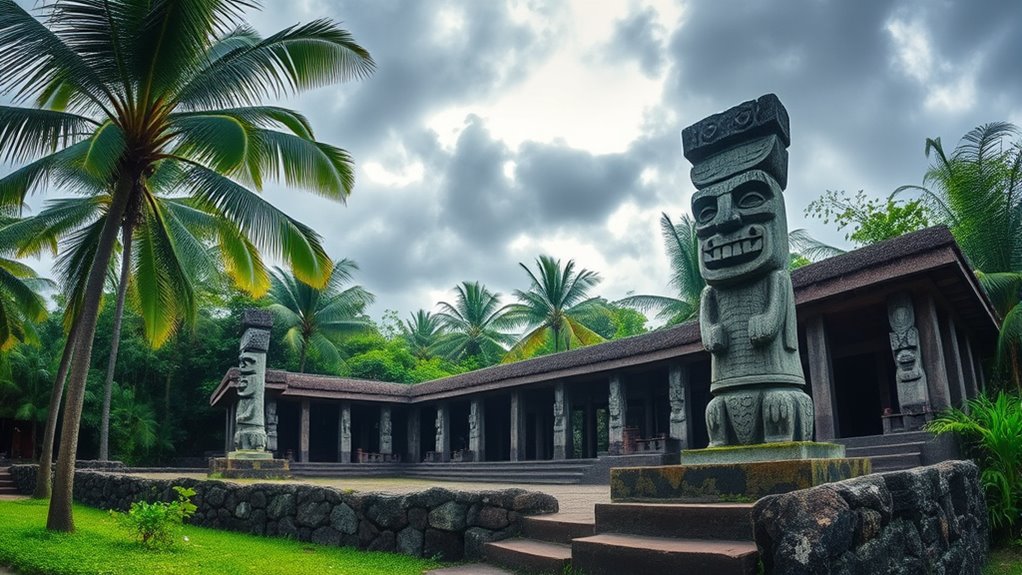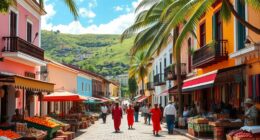Cook Islands’ marae are sacred sites that hold deep cultural and spiritual significance, representing ancestral worship and community identity. However, many face threats from development, neglect, and environmental damage, risking their destruction. Preserving these sites is vital to maintain traditions, stories, and historical connections. If you want to understand how communities are fighting to protect these treasures and why it matters, you’ll find important insights as you explore further.
Key Takeaways
- Many marae in the Cook Islands face threats from development, urbanization, and neglect, risking loss of cultural heritage.
- Proper archaeological preservation is essential to maintain the authenticity and spiritual significance of marae sites.
- Community involvement and awareness are critical for restoring and safeguarding these sacred spaces for future generations.
- Marae serve as vital cultural symbols that embody ancestral worship, tradition, and spiritual connections.
- Without intervention, weathering and human interference threaten the physical integrity of these sacred sites.

A marae in the Cook Islands serves as an essential cultural and spiritual hub where communities gather for ceremonies, meetings, and celebrations. These sacred spaces hold deep significance, acting as living symbols of ancestral worship and cultural identity. When you visit a marae, you’re stepping into a site that embodies generations of history, tradition, and spiritual reverence. The very layout and design of the marae reflect ancestral practices, serving as a physical link to those who came before. Many of these sites are believed to be inhabited by spirits or ancestors, making them vital for ongoing ancestral worship. This spiritual connection is central to the community’s identity, and maintaining the marae’s integrity is crucial for honoring those traditions. Proper archaeological preservation can help ensure the longevity and authenticity of these sites for future generations. However, these sacred sites face increasing threats that put their survival at risk. Development projects, urbanization, and neglect have all contributed to damaging or destroying these culturally significant locations. Without proper archaeological preservation, many marae risk being lost forever, erasing vital parts of the Cook Islands’ history. Archaeologists and local communities work together to document and protect these sites, but limited resources and awareness often hinder preservation efforts. You might not realize that each stone, layout, or artifact at a marae is a piece of a complex puzzle that reveals how ancient Cook Islanders connected with their ancestors. Preserving these archaeological treasures isn’t just about protecting stones and structures; it’s about safeguarding the stories, prayers, and ancestral worship practices embedded within them. Many of the marae are now vulnerable to weathering and human interference. As time passes, the original features are fading, and without intervention, future generations may lack the opportunity to connect with their ancestral roots. You can play a part in supporting conservation initiatives by raising awareness about the importance of archaeological preservation. Protecting marae isn’t just a matter of preserving stone and wood; it’s about ensuring that cultural practices and spiritual connections remain alive. When communities come together for restoration and preservation, they reaffirm their commitment to ancestral worship and cultural continuity. In the face of these threats, it’s essential to recognize the value of these sacred sites. Each marae is a testament to the resilience of Cook Islands’ cultural heritage, and their preservation requires collective effort. By doing so, you help guarantee that future generations can continue to honor their ancestors and carry on the sacred traditions rooted in these ancient spaces. Protecting marae is not just about safeguarding stones; it’s about keeping alive the spiritual heartbeat of the Cook Islands’ cultural identity.
Frequently Asked Questions
How Many Marae Are Still Actively Used Today?
You might wonder how many marae are still actively used today. Many of these sacred spaces hold deep cultural significance, serving as sites for ceremonies and community gatherings. Preservation efforts aim to protect their heritage, ensuring future generations can connect with their roots. While exact numbers vary, it’s clear that ongoing initiatives help keep these marae alive, honoring their historical and spiritual importance in contemporary Cook Islands society.
What Specific Threats Do Marae Face Currently?
Imagine ancient stones standing firm, yet facing silent battles. You see, marae now confront threats like climate change—rising seas threaten to swallow sacred sites, and cultural erosion dulls their significance. These spaces, once vibrant hubs of tradition, struggle to survive as weather worsens and modern influences overshadow their history. You can help preserve these symbols of identity, shielding them from the relentless march of time and the shifting climate.
Are There Any Ongoing Conservation Projects for Marae?
You’re interested in conservation projects for marae, and yes, there are ongoing efforts. These initiatives focus on cultural revitalization and heritage management, ensuring the sacred spaces are preserved for future generations. Local communities, government agencies, and cultural organizations work together to restore and maintain marae, emphasizing their spiritual and historical significance. Through these projects, they aim to protect these essential cultural sites from further decline and promote awareness of their importance.
How Do Local Communities Engage With Marae Preservation?
You can get involved in marae preservation through community involvement and supporting cultural revitalization efforts. By participating in local events, volunteering in conservation projects, and respecting the traditions, you help maintain these sacred spaces. Your active engagement fosters cultural pride and guarantees future generations can connect with their heritage. Community-led initiatives are essential, so your contributions truly make a difference in safeguarding the marae’s spiritual and cultural significance.
Can Visitors Access Marae Freely or Do Restrictions Apply?
Imagine stepping into a sacred garden, where every flower holds a story. You might feel the urge to explore freely, but cultural access and visitor restrictions act as gentle guardians, safeguarding its sanctity. On marae, these restrictions ensure respect for traditions. While some marae allow guided visits, many require permissions, respecting their spiritual significance. So, your access is often limited, honoring the sacredness these spaces hold.
Conclusion
If these marae vanish, you’ll watch our sacred history crumble into dust, like ancient stones erased by a relentless storm. Without their protection, our ancestors’ spirits might be forced to wander lost, crying out for respect that no longer exists. They’re more than stones; they’re the heartbeat of our identity. If we don’t act now, these sacred spaces could disappear forever, leaving behind nothing but echoes of a rich, irreplaceable culture swallowed by neglect.










